Blue is not a common color you would find in snakes, which makes them very interesting. They have also caused fascination in the exotic pet world. The majority of snakes are gray, brown, tan, or black, so finding or seeing a blue snake can be exciting.
There are a number of snakes that are blue, some are uniform blue others will have some blue coloration on them. Continue reading below to find out more about the 20 types of blue snakes.
Table of Contents
Are Blue Snakes Venomous?
All blue snakes are venomous, but their venom is not always dangerous to humans. The blue sea snakes and pit vipers are the most venomous of the blue snakes you may encounter and they should be dealt with great caution.
A bite from one of the venomous blue snakes requires immediate medical attention.
Types of Blue Snakes
1. Blue-lipped Sea Krait
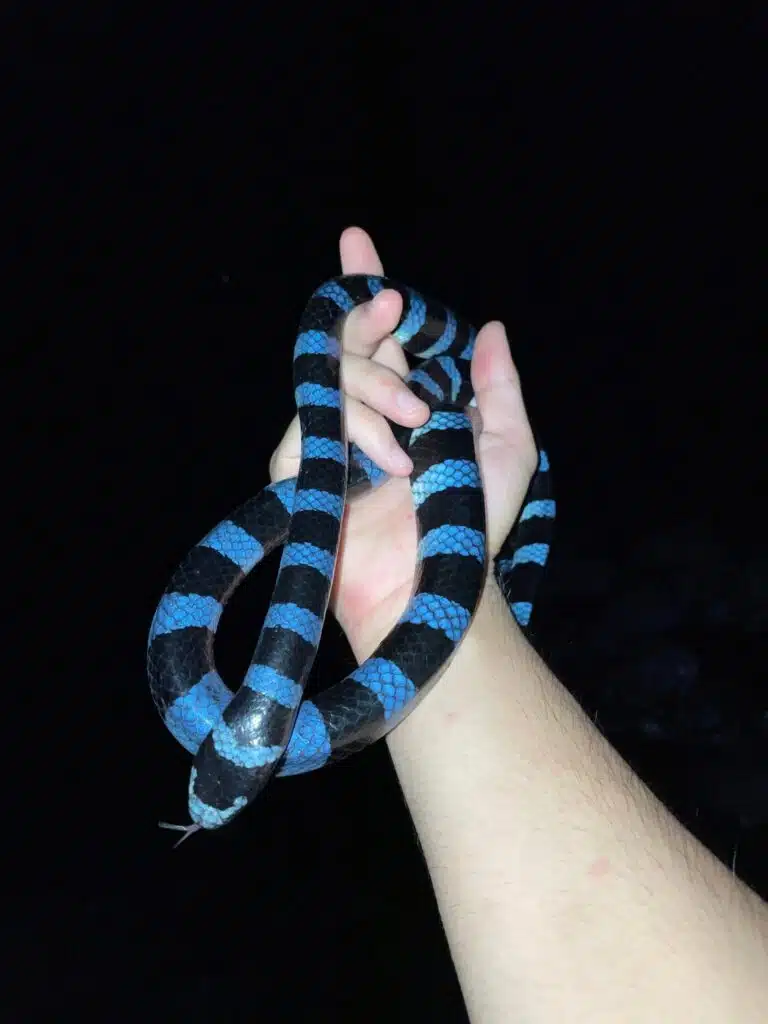
Scientific name: Laticauda laticaudata.
Common name: blue-lipped sea krait, blue-banded sea krait, common sea krait.
The blue-lipped sea krait or the common sea krait is a venomous sea snake, found in the Indian and Western Pacific Oceans. They have large ventral scales with females growing to 1070mm and males to 910mm in body length.
This striking blue and black banded sea snake can be found in Bangladesh, Sri Lanka, Thailand, New Guinea, Philippines, Fiji, Taiwan, Solomon Islands, and Australia, to name a few.
2. Blue Coral Snake
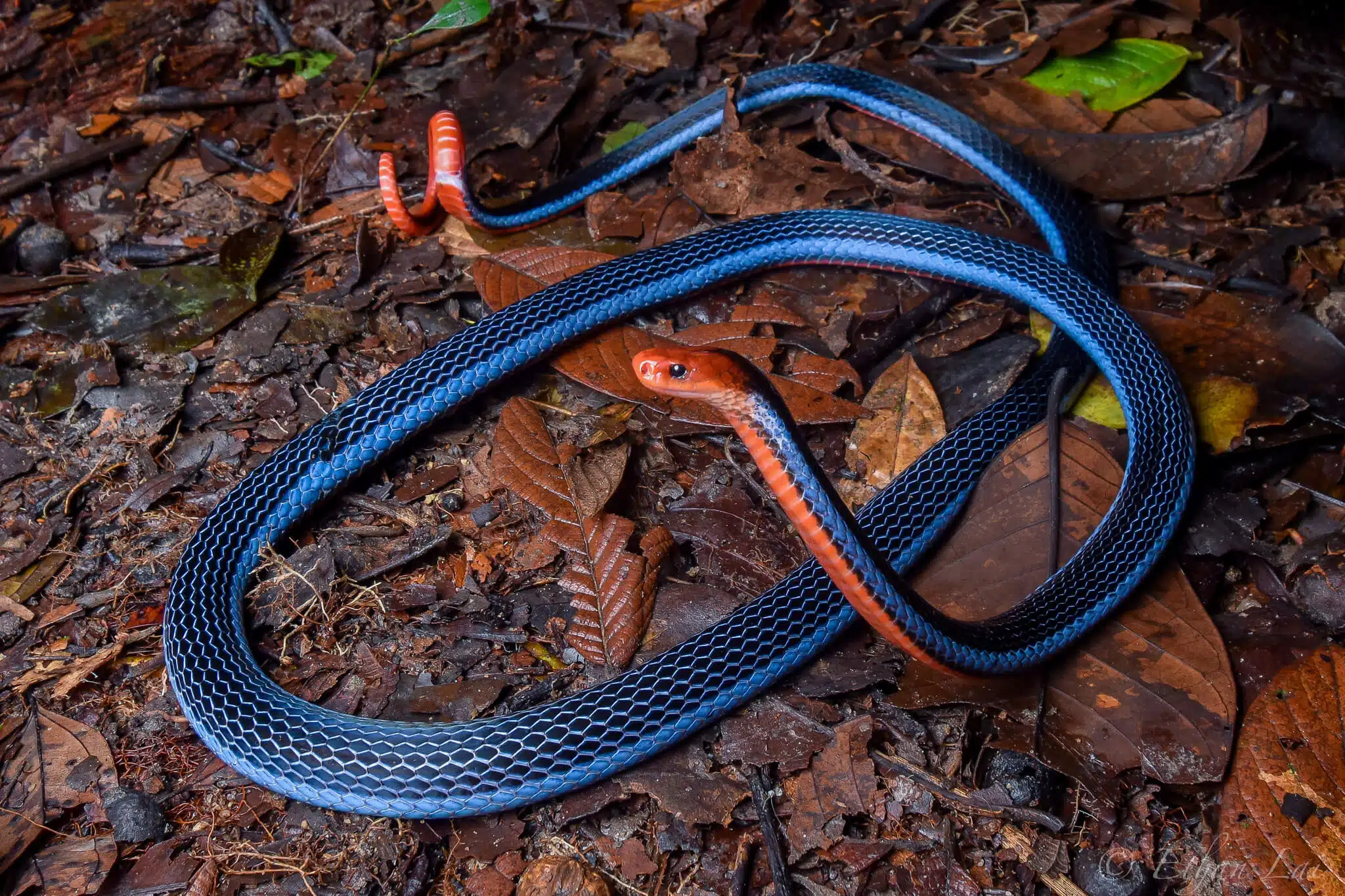
Scientific name: Calliophis bivirgatus.
Common name: blue coral snake, blue Malayan coral snake.
The blue coral snake belongs to the Elapidae family and is native to southeast Asia. It is a new world coral snake of medium size with a slender body. Adults can grow to 1.8 meters in length.
These snakes have a red tail, belly, and head with a dark blue to black on their backs with two large blue to white stripes on their flanks. These snakes are considered venomous with the occasional human death reported.
Their venom is not a neurotoxin, but rather a cytotoxin, which causes immediate paralysis of the victim, prey, or human.
3. Blue Racer
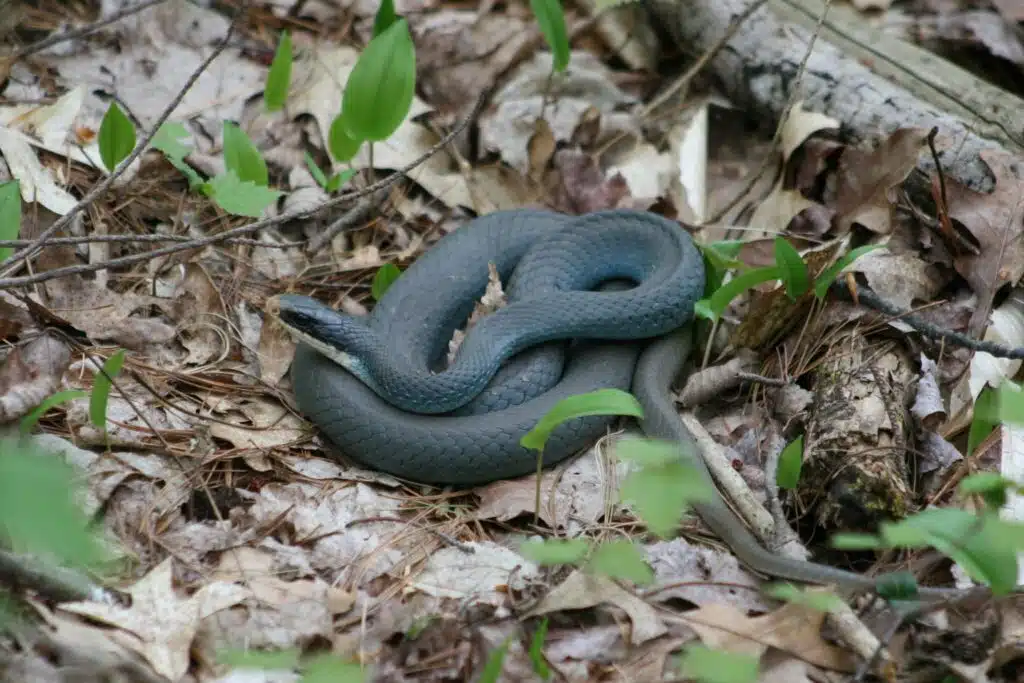
Scientific name: Coluber constrictor foxii.
Common name: blue racer.
Blue racers are non-venomous snakes that live in open and semi-open habitats, such as old fields and savannahs. They are common throughout North America.
These non-venomous snakes have cream to white colored ventral scales with brilliant blue to gray lateral scales and a brown to dark gray dorsum. They have black masts on their face with large eyes and brown to orange snouts.
This is a large snake that can grow to 152cm from snout to vent.
4. Eastern Indigo Snake

Scientific name: Drymarchon couperi.
Common name: eastern indigo snake, indigo, blue indigo snake, black snake, blue gopher snake, and blue bull snake.
The Eastern indigo snake is a large non-venomous snake that is native to the southeastern United States. These snakes are a uniform blue/black with some having a red to orange or tan-colored throat, chin, and cheeks.
They are smooth scaled snakes with males growing to 2.36 meters and weighing 4.5 kilograms and females growing to 2 meters and weighing 2.7 kilograms. They prefer flat woods, dry glade, cane fields, riparian thickets, well-drained sandy soil, and stream bottoms.
Due to their docile nature and blue coloration, these snakes have become desirable pets in the exotic pet trade. Though in some states in the US you will need a permit in order to keep one as a pet.
5. White-lipped Island Pit viper
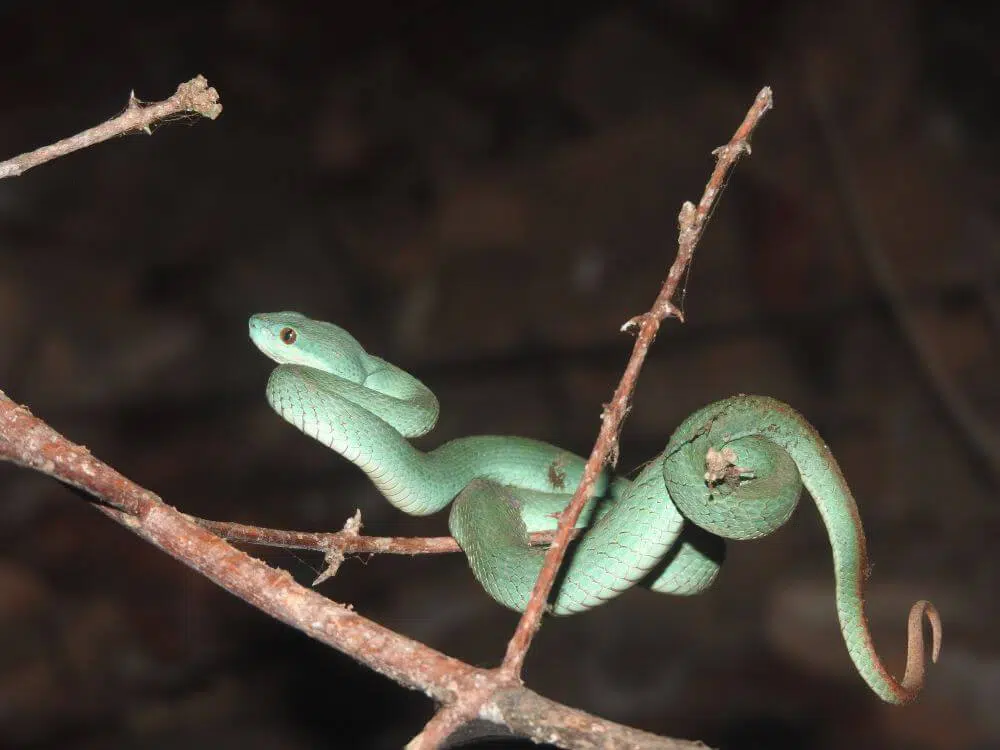
Scientific name: Trimeresurus insularis.
Common name: white-lipped island pitviper, Sunda Island pitviper.
White-lipped island pit vipers are venomous snakes found in eastern Java and the Lesser Sunda Islands. It is also known as the Sunda Island pit viper. Their color varies from green to blue/green, with some having yellow coloration.
They are tree dwellers and are often encountered in dry monsoon forests.
6. California red-sided garter snake
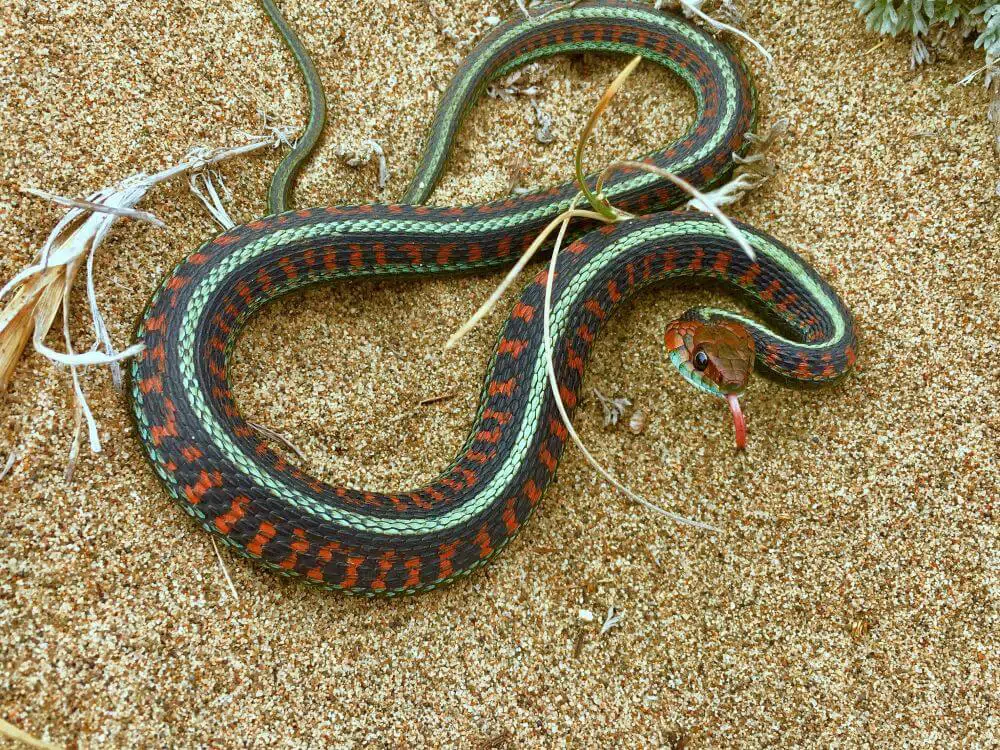
Scientific name: Thamnophis sirtalis infernalis.
Common name: California red-sided garter snake.
The California red-sided garters name is a slender snake indigenous to North America. The majority of these snakes have a blue stripe on the black and red background, growing to 100cm in total length.
These snakes feature a pattern of three stripes, which include blue and yellow stripes on a red body with black spots on the striped pattern. They can vary slightly in appearance with some having an orange or red head.
The California red-sided garter snake is found primarily in marshes and coastal dunes in California. They are listed as endangered in the US Endangered Species Act.
They are usually near permanent or almost permanent water areas, such as dunes, shallow waters, and marshlands. They sometimes live temporarily in woodlands and grasslands.
7. Eastern Garter Snake
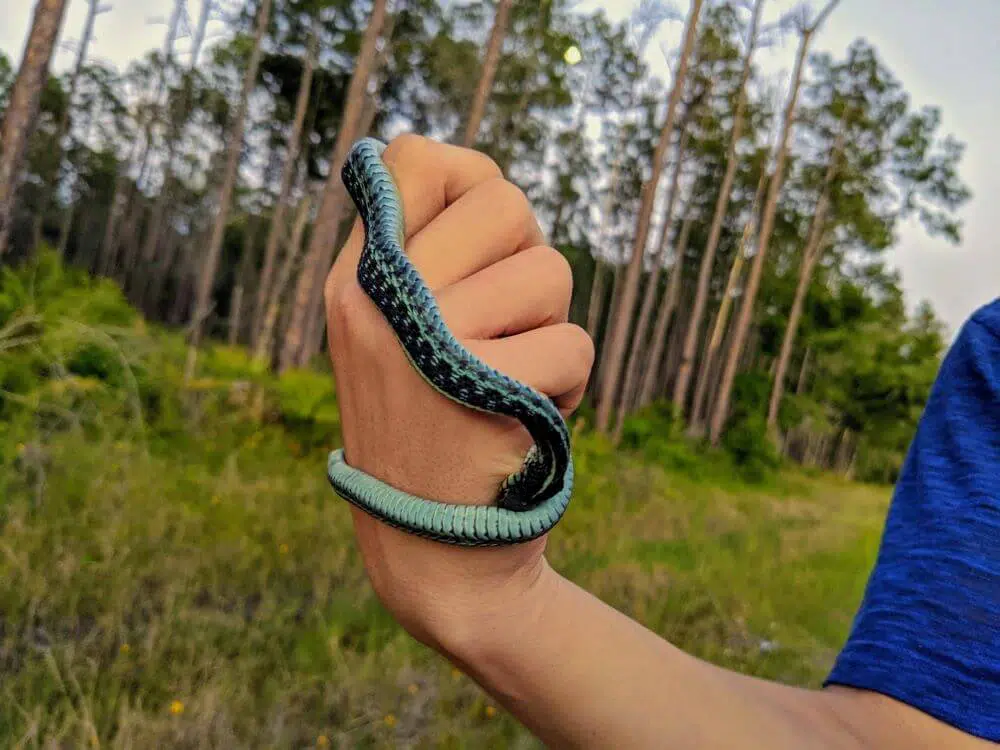
Scientific name: Thamnophis sirtalis sirtalis.
Common name: eastern garter snake.
The Eastern garter snake is a medium-sized North American snake. They grow to 66cm in body length with females being larger than males.
Their coloration can range from blue/green to brown or black with yellow or white stripes. They live in a variety of environments, preferring shrubby fields and grassy areas. They are often encountered in abandoned farmlands, outbuildings, and trash dumps.
8. Malabar Pit Viper
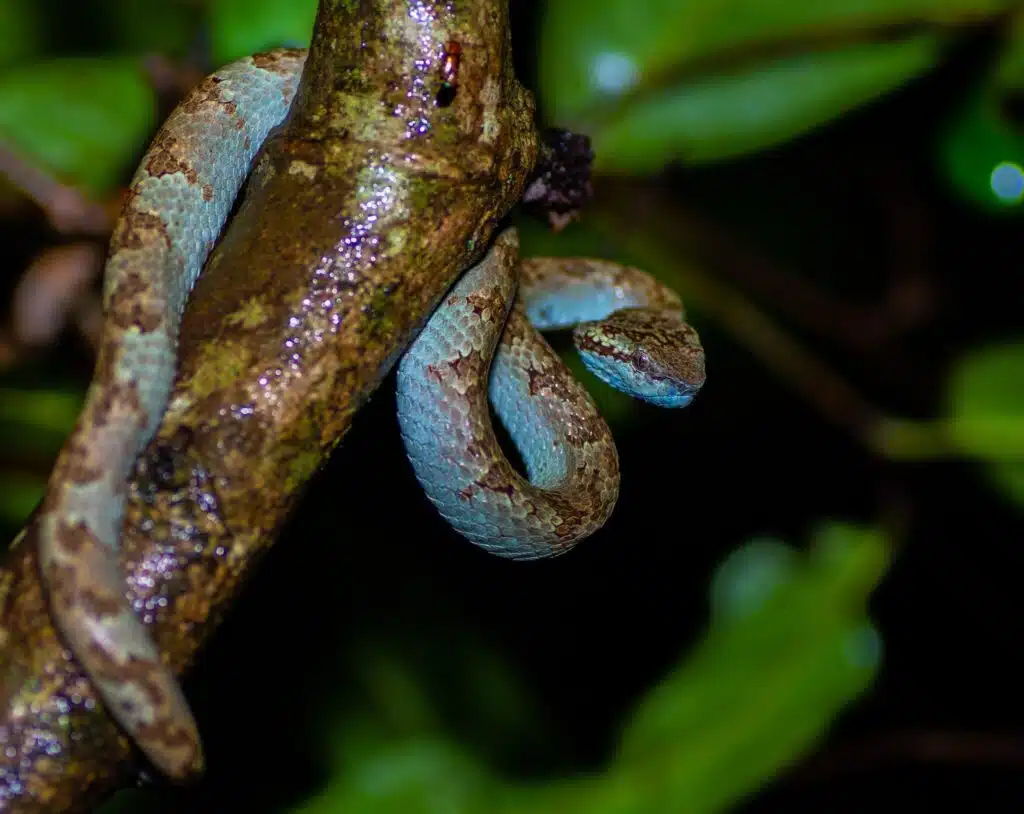
Scientific name: Craspedocephalus malabaricus.
Common name: Malabar pit viper, Malabar rock pit viper, rock viper.
The Malabar pit viper or the rock viper is a venomous pit viper endemic to southwestern India. These vipers can grow to 105 cm snout to vent. There are a number of different color morphs from yellow or green to brown or light blue. Some have patterns.
They are slow-moving snakes, but are fast to strike. If bitten, you can experience swelling and moderate pain which will subside within a couple of days.
9. Side-striped Palm Pit Viper
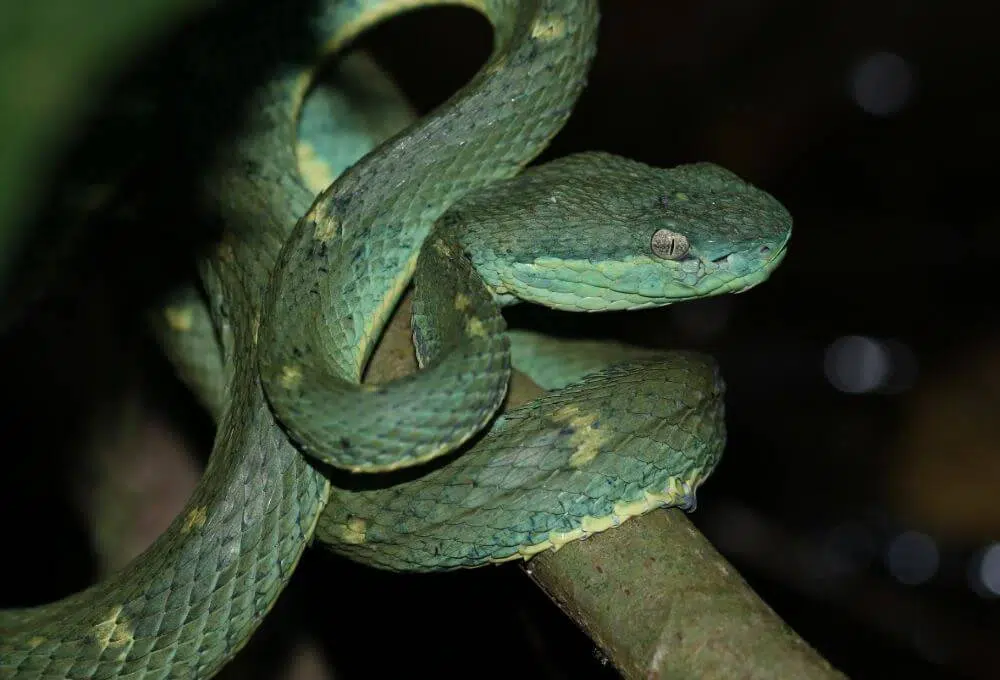
Scientific name: Bothriechis lateralis.
Common name: side-striped palm pitviper, side-striped palm viper.
The side-striped palm pit viper is a venomous snake found in the Costa Rica mountains, along with western Panama. They are slender snakes, usually emerald green to a blue/green color, with yellow alternating vertical bars.
The belly is a uniform yellow/green, both sides are bordered with a pale yellow stripe. Their green heads have a blueish stripe, which is not always present. Captive adults tend to turn blue with age with some blue specimens also being identified in the wild.
The side-striped pit viper can be found in the lower Montane forest, the lower Montane wet forest, and the Lower Montane rain forest. If bitten it is considered a serious bite and you should seek immediate medical attention, even though fatalities are rare. There is an anti-venom available.
10. Baron’s Green Racer

Scientific name: Philodryas baroni.
Common name: Baron’s green racer.
The Baron’s green racer is a venomous snake endemic to South America. These snakes can grow to 180cm in length with males being slightly smaller than the female. Their tails account for almost thirty percent of their body length.
They have small, elongated heads with a flexible nasal protuberance, or rostral scale, which is more predominant in males. They can vary in color from green to blue or brown. They can be uniform or they can have black stripes on their backs and sides.
These tree snakes are active during the day and are not usually aggressive if it gets a fright. They may emit a foul-smelling odor. They have rear fangs and are venomous, so they should be treated with caution and are considered dangerous to humans.
11. Guatemalan Palm-Pit Viper
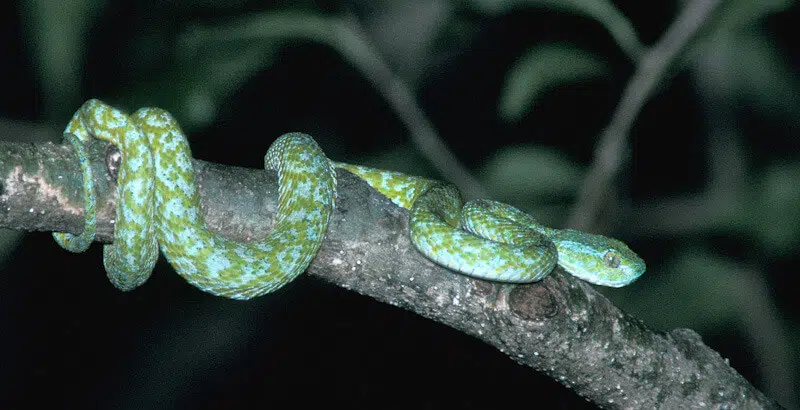
Scientific name: Bothriechis bicolor.
Common name: Guatemalan palm-pit viper, Guatemalan tree viper.
The Guatemalan palm pit viper is a venomous pit viper found in Southern Mexico, Honduras, and Guatemala. Adults can grow up to 100cm with a slender body and color patterns ranging from a green to a blue/green ground color without any patterns.
Mexican specimens may have black dots or flecks or blue patches. The head is a uniform green with the interstitial skin being blue. Some scales may be bordered in blue. These snakes are usually encountered in rain forests.
12. Rock Rattlesnake
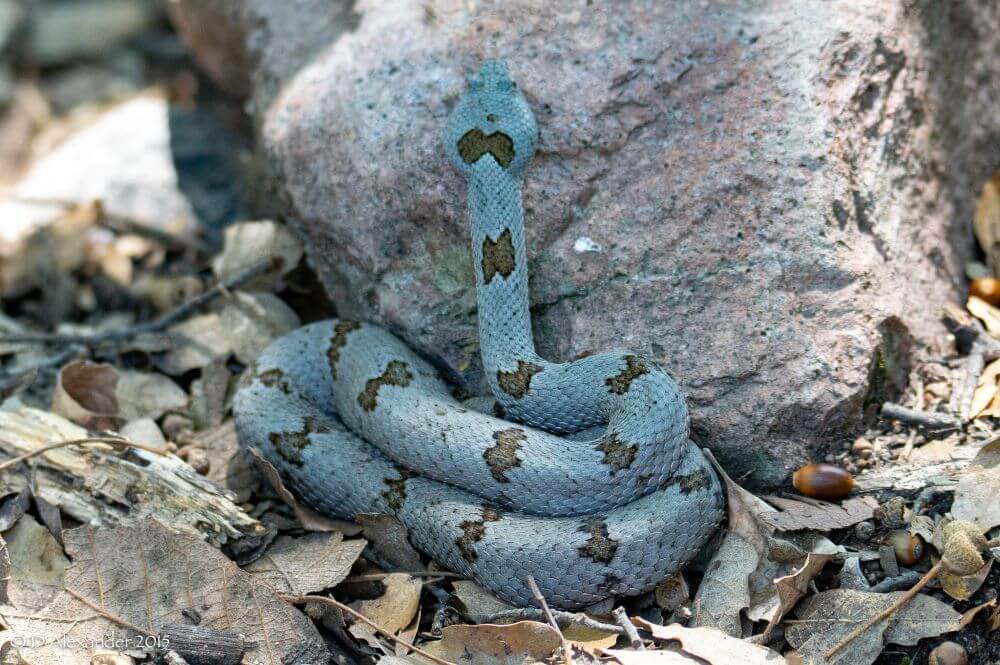
Scientific name: Crotalus lepidus.
Common name: rock rattlesnake, green rattlesnake, blue rattlesnake.
The rock rattlesnake belongs to the pit viper family and is a venomous snake in the southwestern United States and North Mexico. These are not large snakes, growing to around 81cm in length.
They have large round heads and heavy bodies, their tails have a rattle, which is made of keratin. Each time their molt, there is a new segment added to their rattle. They vary in color, usually reflecting the color of the rock in the snake’s environment.
Snakes near limestone tend to be light gray to blue in color, while those at higher altitudes have darker coloration. They have clear banding with no mottling or specks.
Their venom is haemotoxin, which has neurotoxic effects. A bite from this pit viper should be considered a medical emergency.
13. Eyelash Viper
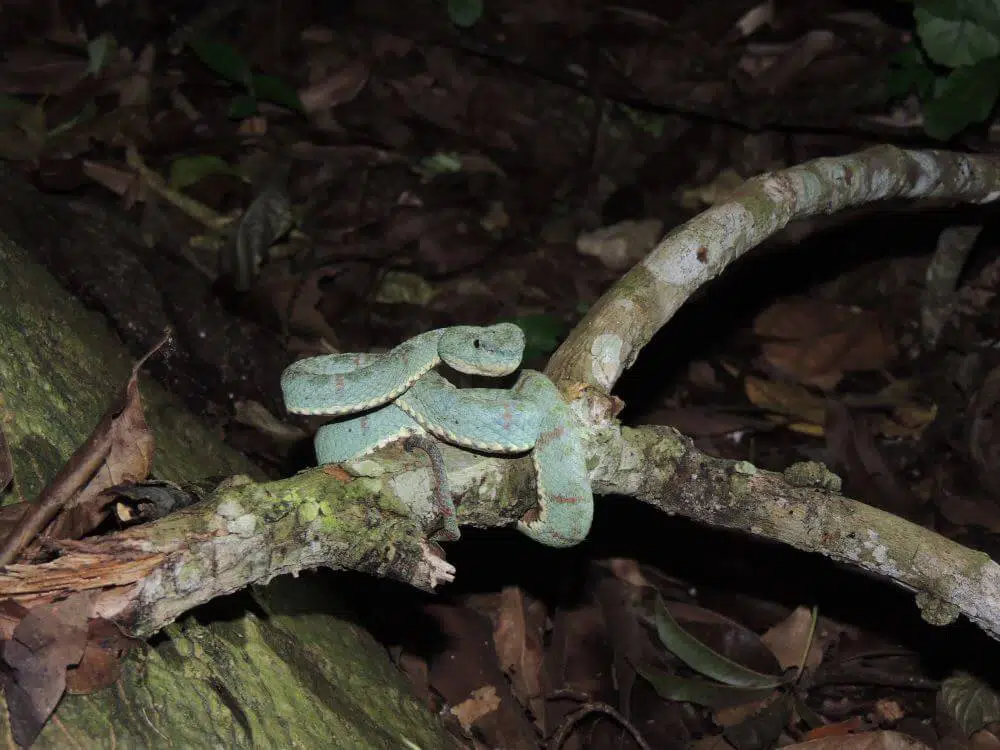
Scientific name: Bothriechis schlegelii.
Common name: eyelash viper.
The eyelash viper is a venomous pit viper, which is native to Central and South America. These are small, tree-dwelling snakes, which come in a range of color variations, from green to blue.
These snakes grow to around 82cm in length with the females being longer than the males. They have a triangular-shaped head with needle-like fangs at the front of their jaw. They have heat organs on both sides of the head, right between the nostril and the eye.
The set of scales just above its eyes, look like eyelashes, which is where this viper got its name. These snakes can be found in red, yellow, green, brown, pink, and blue. Some have black or brown specs, others have no pattern.
They prefer humid and tropical areas with plenty of foliage and close to a permanent water source. They are mostly nocturnal, feeding on small birds, lizards, rodents, and frogs. They are aggressive and will strike if harassed.
14. Common Tree Snake
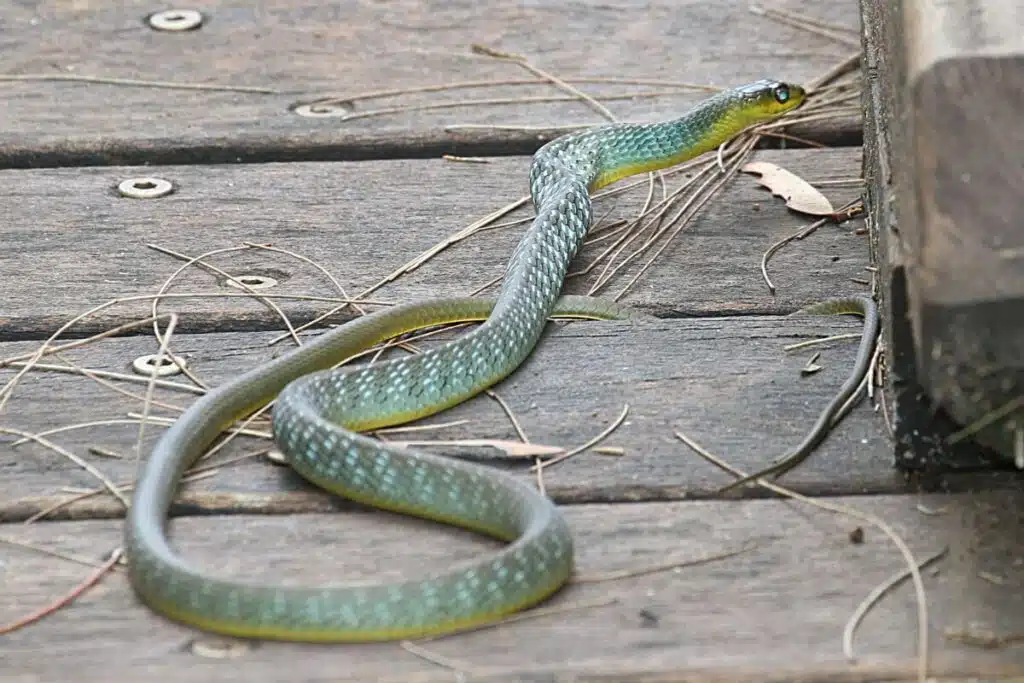
Scientific name: Dendrelaphis punctulatus.
Common name: Australian tree snake, common tree snake, green tree snake.
The Common Tree Snake is a species that also comes in a blue morph, apart from its dominant green appearance.
At least 2 common blue morphs are seen on this snake. Blue side nuances are specific to the snake which may also come in dark blue or dark gray mid-dorsal nuances.
The species is commonly yellow on the underside.
All of these morphs of The Common Tree Snake are widespread. It’s estimated there are more indoor Common Tree Snake sightings than any other species in Australia.
Spotting this snake indoors may seem alarming, but Common Tree Snakes aren’t venomous.
It can enter homes next to bushland, rivers, or next to forests from Southern Australia to New Guinea.
15. Blue-striped Ribbon Snake
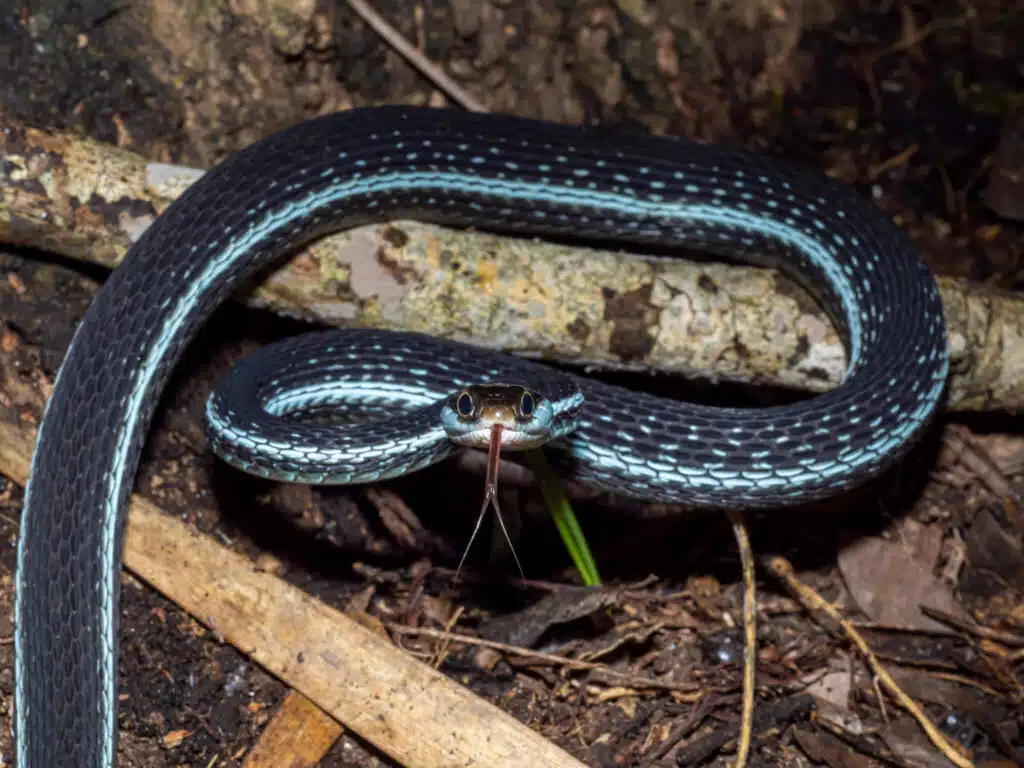
Scientific name: Thamnophis saurita nitae.
Common name: bluestripe ribbon snake.
A type of garter snake, Blue-striped Ribbon Snakes are named after their atypical appearance.
As the name of the species implies, this is a type of snake with thin blue stripes that run from the head to the tip of the tail.
Apart from the bright blue stripes, there are other blue sections on the snake, such as the area around its mouth.
The tip of its snout is also not black, like the rest of its dorsum, but rather tan and brown.
Some color variation is specific to these snakes, as they become adults from juveniles.
Many juveniles are partly black and partly olive-green with blue stripes. They only darken as they age.
Blue-striped Ribbon Snakes live around The Gulf of Mexico, mostly in Florida.
It’s here they navigate both terrestrial habitats and aquatic habitats but they aren’t as common as other stripes snakes of the state.
16. Sri Lankan Green Pit Viper

Scientific name: Craspedocephalus trigonocephalus.
Common name: Sri Lankan pit viper, Ceylon pit viper, Sri Lankan green pitviper, pala polonga.
Most snake colors are characteristic of a species, its morphs, and subspecies both males and females.
The Sri Lankan Green Pit Viper is one of the multiple exceptions in the snake world where males have different colors to females.
Males of the species are dominated by blue or blue-green nuances whereas females are mostly green.
While the black patterns of the dorsum are similar among males and females, there’s a clear difference in their main nuances.
Yellow spots and sections are specific to the underside of both males and females.
Sri Lankan Green Pit Vipers are venomous. They are not believed to produce a sufficient venom yield to kill humans, but they are still seen as highly dangerous.
While their bites don’t kill people, they can still inflict pain that lasts.
17. Puget Sound Gartersnake
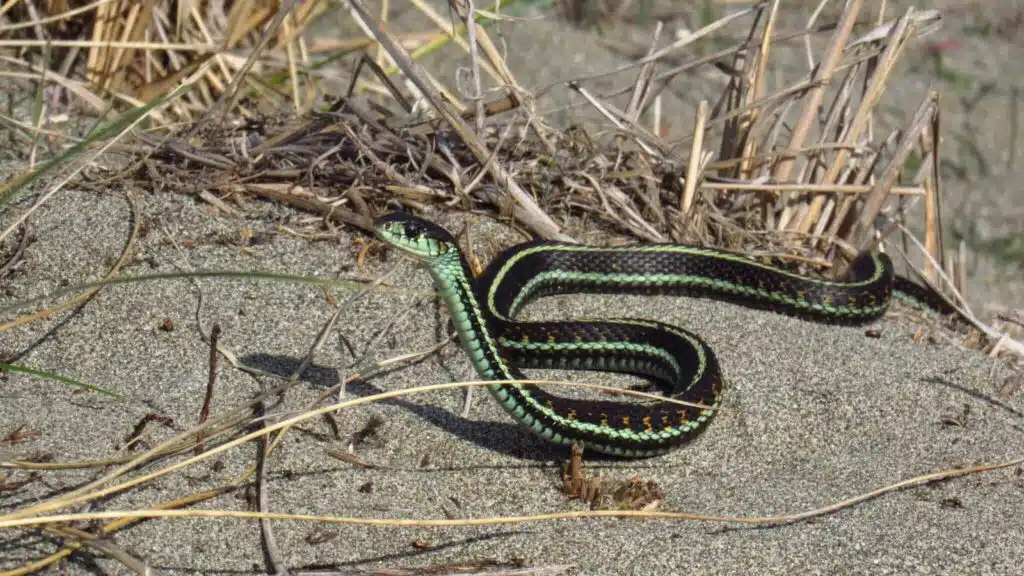
Scientific name: Thamnophis sirtalis pickeringii.
Common name: Puget Sound Gartersnake.
One of the rarest types of snakes in terms of color combinations is The Puget Sound Gartersnake.
This is a species that shows the same blue nuances on its thin dorsal stripes as the nuance of its underbelly.
Puget Sound Gartnersnakes additionally exhibit blue sections around the mouth.
The blue nuances on the snake can vary as well. Initially bright blue, these areas darken to dark blue as the snake ages.
Further color variation is specific as snakes age. Blue-green colors may replace the more vivid blue nuances on younger Puget Sound Gartersnakes.
However, the black and blue color combination is just a morph of The Puget Sound Gartersnake, which can also be yellow and black or yellow and dark gray.
18. Rhinoceros Viper
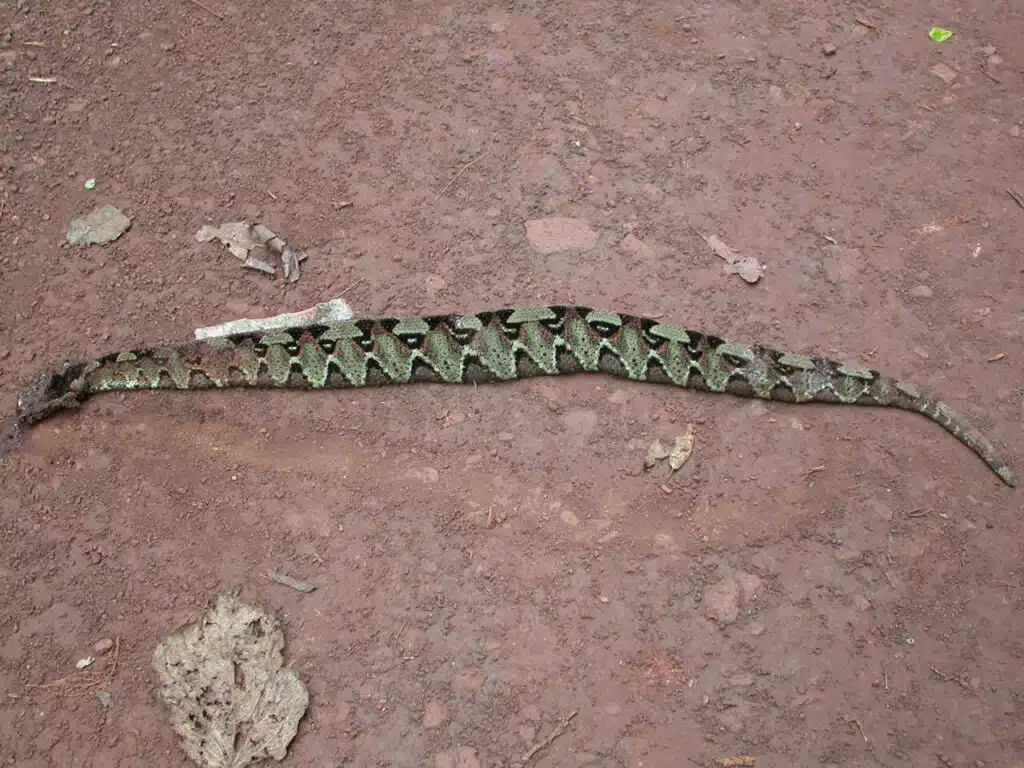
Scientific name: Bitis nasicornis.
Common name: butterfly viper, rhinoceros viper, river jack.
A highly patterned species, Rhinoceros Viper snakes show blue patterns from their early lives.
This snake species has V-shaped blue markings on the head with additional blue stripes and bands along the mid-dorsum as juveniles.
Once they mature, the snakes start to darken. This is also seen in the vivid blue sections on the dorsum which start to become blue-gray.
A species found in multiple African countries such as Ghana, Rhinoceros Vipers use their multiple colors as camouflage.
A fierce predator, the snake uses ambushing techniques to catch its next meal. It can stay motionless for a long time to wait for suitable prey to be within grabbing distance.
A highly venomous species, this blue snake can easily kill humans with a single bite.
Still, not all Rhinoceros Viper bites are deadly. This snake can fold its fangs and deploy them only when truly necessary.
Its fangs are folded into its mouth but they can be lowered whenever the snake needs to inject venom with a bite.
19. Smooth Greensnake
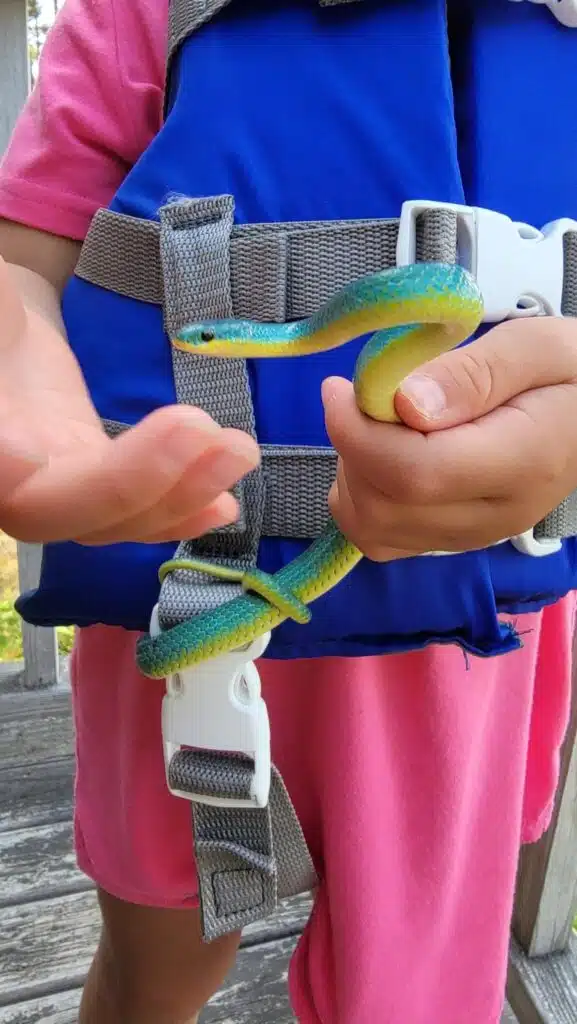
Scientific name: Opheodrys vernalis.
Common name: smooth green snake, grass snake.
Smooth Greensankes are native to many Southern US regions.
These snakes are named after their vivid green color and few can associate the species with a blue snake.
However, some young Smooth Greensankes can be blue, entirely blue. This is based on their age as much as on their region.
Juvenile Smooth Greensnakes in Kansas have a bright blue color.
The color is uniform across the dorsum with slightly brighter blue nuances characteristic to the lower sides.
Yellow or bright green ventral colors may be specific to these bright blue juveniles.
Smooth Greensnakes in Kansas may only be blue for a few months, up until their first molt when they become bright green, their more common adult nuance.
20. Common Bamboo Vipers
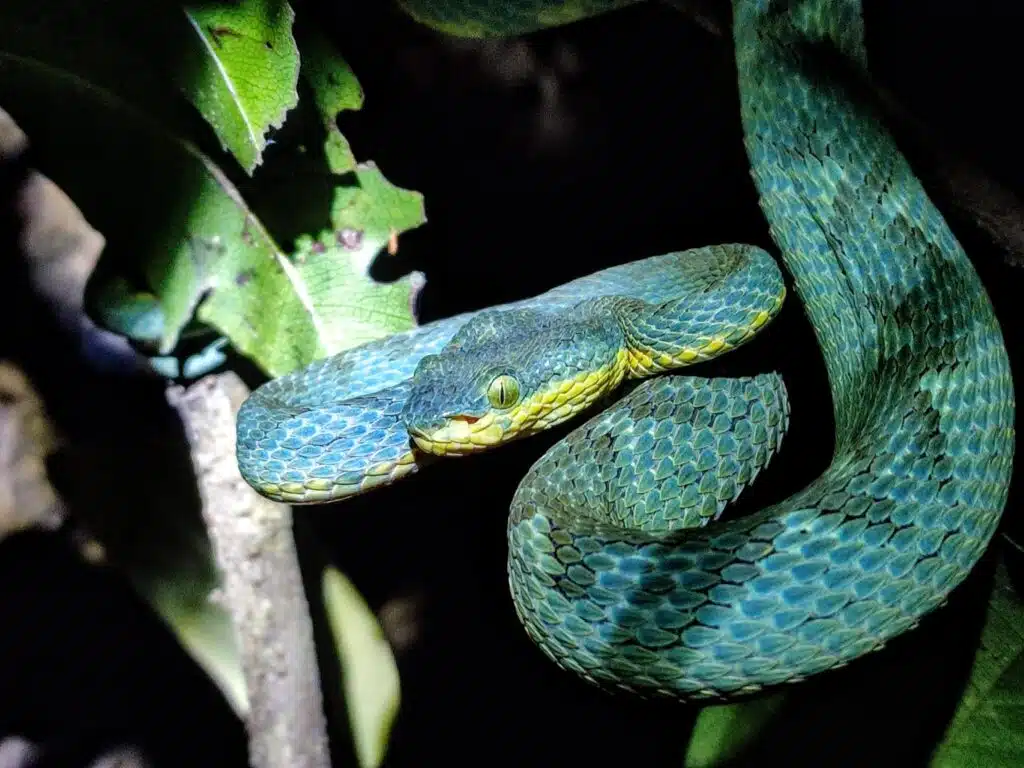
Scientific name: Craspedocephalus gramineus.
Common name: bamboo pit viper, Indian green pit viper, common green pit viper.
A venomous pit viper of Southern India, Common Bamboo Vipers are known for their vivid colors.
Dominated by bright green nuances, The Common Bamboo Viper also has a bright yellow ventral color.
Ares on the sides between the green and the yellow sections can often appear bright blue. These are areas that can also be bright brown and even purple.
Much of the color variations of the species depend on its age and region, as some populations have also been reported in the Northern parts of India.
An arboreal species, Common Bamboo Vipers also have different eye colors depending on their morphs. The blue and green morph often displays bronze-green eyes.
This is an arboreal species that may adapt its colors to its surroundings.
Snakes of this genus eat all types of small prey including small rats. A typical venomous Common Bamboo Viper grows to a size of around 5 feet and shows aggressive behavior at all life stages.
Summary
While blue is not a common color for snakes, there are some that have blue, either as a base color or they have blue in their pattern. The blue coloration makes these snakes interesting and exciting to exotic pet enthusiasts around the world.
Further Reading: